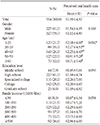Abstract
Objectives
This study was conducted to analyze the effect that oral health literacy of adults has on perceived oral health state and to identify the factors that affect perceived oral health status.
Methods
A self-administered questionnaire survey was distributed to 554 adults who lived in the Daegu or Gyeongbuk areas and visited dental institutions located in the Daegu area. For adults who were 60 years old or older, direct interviews were conducted. Statistical analysis was performed with t-tests, analysis of variance, and multiple regression using SPSS.
Results
Between oral health literacy and perceived oral health status, a significant positive correlation was revealed (r=0.142, P<0.01). A significant positive correlation was revealed between oral health literacy and knowledge (r=0.397, P<0.01). A significant but weakly positive correlation was revealed between oral health knowledge and perceived oral health status (r=0.086, P<0.05).
To identify factors affecting perceived oral health status, multiple regression analysis was conducted, and the result showed that oral health literacy was a statistically significant factor (β=0.105, p<0.05). Among general characteristics, age was a statistically significant negatively affecting factor, as it showed a negative relationship with perceived oral health status (β=−0.140, P=0.001, adjusted R2=0.049).
Figures and Tables
References
1. CSDH. Closing the gap in a generation: Health equity through action on the social determinants of health. Commission on social determinants of health final report. Geneva: World Health Organization;2008. p. 1–247.
2. Williams MV, Baker DW, Parker RM, Nurss JR. Relationship of functional health literacy to patients' knowledge of their chronic disease. A study of patients with hypertension and diabetes. Arch Intern Med. 1998; 158:166–172.


3. Schillinger D, Grumbach K, Piette J, Wang F, Osmond D, Daher C, et al. Association of health literacy with diabetes outcomes. JAMA. 2002; 288:475–482.


4. Kim S, Love F, Quistberg DA, Shea JA. Association of health literacy with self-management behavior in patients with diabetes. Diabetes Care. 2004; 27:2980–2982.


5. Gazmararian JA, Williams MV, Peel J, Baker DW. Health literacy and knowledge of chronic disease. Patient Educ Couns. 2003; 51:267–275.


6. Lee JY, Divaris K, Baker AD, Rozier RG, Vann WF Jr. The relationship of oral health literacy and self-efficacy with oral health status and dental neglect. Am J Public Health. 2012; 102:923–929.



7. Berg HJ, Slayton BL. Early child oral health. Iowa: Wiley-Blackwell;2009. p. 200–201.
8. Horowitz AM, Kleinman DV. Oral health literacy: a pathway to reducing oral health disparities in Maryland. J Public Health Dent. 2012; 72:Suppl 1. S26–S30.

9. Baur CE, Comings JP, Evans C, Garcia R, Horowitz AM, Ismail AI, et al. The invisible barrier: literacy and its relationship with oral health. J Public Health Dent. 2005; 65:174–182.


10. Jones M, Lee JY, Rozier RG. Oral health literacy among adult patients seeking dental care. J Am Dent Assoc. 2007; 138:1199–1208.


11. Song KH, Jung SH. A study on the evaluation of health related quality of life in Korean adults. J Korean Acad Dent Hyg. 2009; 11:25–43.
12. Kim MJ, Lim CY. Correlation of self-perceived oral health status and objective oral health status of adults. J Korea Acad Industr Coop Soc. 2017; 18:375–381.
13. Lee JY, Rozier RG, Lee SY, Bender D, Ruiz RE. Development of a word recognition instrument to test health literacy in dentistry: the REALD-30 A Brief communication. J Public Health Dent. 2007; 67:94–98.


14. Parker EJ, Jamieson LM. Associations between Indigenous Australian oral health literacy and self-reported oral health outcomes. BMC Oral Health. 2010; 10:3.



15. Kaur N, Kandelman D, Nimmon L, Potvin L. Oral health literacy: Findings of a scoping review. EC Dent Sci. 2015; 2:293–306.
16. Ayyagari P, Ullich F, Malmstrom TK, Andresen EM, Schootman M, Miller JP, et al. Self-rated health trajectories in the African American health cohort. PLoS One. 2012; 7:e53278.

17. Lim SA. Convergence factors of subjective oral health awareness perception on oral health improvement behavior in some university student. J Korean Converge Soc. 2017; 8:167–175.
18. Sabbahi DA, Lawrence HP, Limeback H, Rootman I. Development and evaluation of an oral health literacy instrument for adults. Community Dent Oral Epidemiol. 2009; 37:451–462.


19. Lee BE, Kim YH. Association between oral health literacy and oral health behaviors of adults in Korea. Health Soc Sci. 2014; 37:87–102.
20. Hirai T, Ishijima T, Koshino H, Anzai T. Age-related change of masticatory function in complete denture wearers: evaluation by a sieving method with peanuts and a food intake questionnaire method. Int J Prosthodont. 1994; 7:454–460.

21. Kim KW, Lee KS, Kang PS, Kim WH, Lee HK. Comparison of chewing ability and quality of life before and after the dental implantation. J Korean Acad Prosthodont. 2009; 47:215–221.

22. Kim NH, Kim HD, Han DH, Jin BH, Paik DI. Relationship between perceived oral symptoms and perceived oral health status among the elderly in welfare institutions in Seoul. J Korean Acad Oral Health. 2006; 30:141–150.
23. Park JR, Lee YK. Research on the subjective status of oral cavity's health following senior citizens'characteristics. J Korean Acad Dent Hyg Edu. 2009; 9:344–356.
24. Ryu DY. Development of oral health literacy instrument for Korean children's care giver [dissertation]. Gangneung: Gangneung-Wonju National University;2013. [Korean].




 PDF
PDF ePub
ePub Citation
Citation Print
Print







 XML Download
XML Download